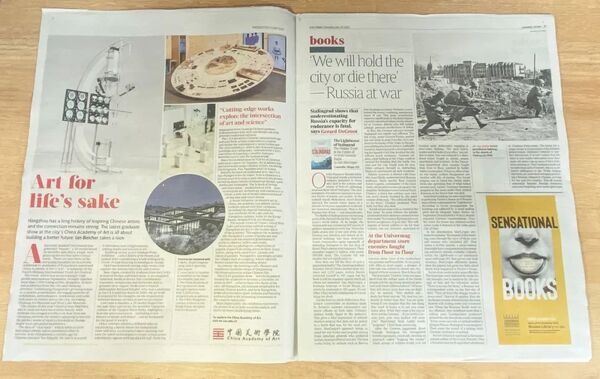日前,英国主流媒体《泰晤士报》整版刊文“Art for life’s sake”(参考译文:因生活而艺术),报道中国美术学院2022届毕业作品展,透过“生活力”主题,观察中国高等艺术院校在艺术与科技融合方面的前沿探索,以及艺术助力城市发展的创新实践。
此前,《泰晤士报》官方脸书账号“The Times and The Sunday Times”在发布预热推文时,文章的主笔编辑伊恩·贝尔彻认为,今年中国美术学院毕业展的主题“生活力”恰逢其时。毕业展鼓励学生们反思我们的生活正在发生的变化,以及世界如何适应由技术的快速变革带来的影响。

《泰晤士报》报纸版面实拍图

《泰晤士报》报纸版面实拍图

《泰晤士报》官方脸书账号发布截图
早在2019年,《泰晤士报》就曾刊文“Natural wonder——Hangzhou Living poetry”(参考译文:探索自然胜境——最忆是杭州),认为杭州是中国千年来活力不断的灵感来源地。在“Art for life’s sake”一文中,《泰晤士报》就位于杭州的中国高等艺术学府——中国美术学院,再次提及:“平远的西湖和幽远的象山均对中国美术学院精神的培养起到了关键作用。在中国美术学院的发展历程中,杭州山水与建筑的自然结合激发了一代代艺术家不断观察、反思和创作。”
 中国美术学院象山校区实景图
中国美术学院象山校区实景图
此次《泰晤士报》特别关注了今年毕业展中3个探索艺科融合的前沿作品代表,均来自创新设计学院。作品《后设器官》为纪念于2020年去世前一直担任中国美术学院教授的法国哲学家贝尔纳·斯蒂格勒而创作,灵感来自他对人类、技术和社会器官之间关系的思索;作品《瑶山心语》突显了良渚地区的资源,包括其丰富的音乐和舞蹈历史,思考如何加以利用,造福社会;播撒虚拟种子的高科技种植设备的作品《绿易》,则从中国古典园林中汲取灵感,展示了科技和设计如何促进传统文化的发展。
《泰晤士报》认为,“中国美术学院在展品中传承中国文化遗产,并用新颖的艺术表现形式探索和定义当代社会图景。整个展览彰显中国美术学院的核心理念,即激发自然与人类心灵的创造性对话。”

作品《瑶山心语》展览现场实拍图

作品《绿易》展览现场实拍图
自2010年开始,中国美术学院以“毕业展示周”的全新形式全面展示教学创作成果,开中国艺术学院之先河;2019年,中国美术学院再次冲破“围墙”,将常规的毕业季展览升级成为艺术周。之后的每一年,规模和场域不断升级延伸,如今中国美术学院的“毕业季”已经成为杭州的城市节日,让市民畅享艺术狂欢之乐。
对此,《泰晤士报》评价:“中国美术学院毕业作品展表明,艺术正助力城市发展,迎接不断涌来的各种挑战。”
《泰晤士报》创刊于1785年,是英国全国发行的综合性日报,对全世界政治、经济、文化发挥着巨大影响。
《泰晤士报》关注中国美术学院艺科融合发展成果海报(刘畅设计)
以下是《泰晤士报》刊发的“Art for life’s sake”全文及中文对照版:
Art for life’s sake
因生活而艺术
Hangzhou has a long history of inspiring Chinese artists and the connection remains strong. The latest graduate show at the city’s China Academy of Art is all about building a better future. Ian Belcher takes a look.
杭州有着给中国艺术家带来灵感和启发的悠久历史,生活与艺术在杭州紧密相连。今年6月,中国美术学院举办了毕业作品展,其主题聚焦于建设一个更加美好的未来。伊恩·贝尔彻带你来看看这个作品展。
A futuristic medical instrument that generates “organs”, a 3D model based on neolithic jade discs, a high-tech planting device that sows virtual seeds… These are just three of the intriguing installations in a recent exhibition by graduates of Hangzhou’s renowned China Academy of Art (CAA) – mainstay of the Fourth Zhijiang International Youth Art Festival.
生产“器官”的未来医学仪器、基于新石器时代玉石圆盘的3D模型、播撒虚拟种子的高科技种植设备……这还仅是位于杭州的中国美术学院的毕业生们最近展出的三个有趣装置。中国美术学院是第四届之江国际青年艺术周的主办方。
The event, which has an increasingly high-profile international reputation, brought together more than 5,000 young artists, designers, writers and academics from the city and the surrounding province of Zhejiang. Underlining Hangzhou’s growing status as a creative powerhouse, the engaging series of exhibitions, performances, workshops and discussions took place in venues across the city, including Zhejiang Art Museum and West Lake Museum.
近年来,中国美术学院毕业作品展国际声誉不断提升,本次展览汇集了来自杭州和浙江省内其他地区的5000多名青年艺术家、设计师、作家和学者。浙江美术馆、西湖博物馆等场馆举办了一系列引人入胜的展览、演出、研讨会,突显了杭州日益提升的创意中心地位。
The theme of this year’s festival was Vital Force, and it could not have been more timely, with students encouraged to reflect on the way our lives are changing and how the world is adapting to survive the perfect storm of rapid technological change.
今年艺术节的主题是“生活力”,这个主题恰逢其时。毕业展鼓励学生们反思我们的生活正在发生的变化,以及世界如何适应由技术的快速变革带来的影响。
The idea of “vital force”, which refers to both individual energy and a communal effort to survive, was championed a century ago by Chinese educator Tao Xingzhi. He saw it as a path to liberation and enlightenment, adding depth and realism to art.
一个世纪前,中国教育家陶行知提出了“生活力”这一概念,它既指个人的生存能力,也指集体的生存努力。陶行知认为这是一条通往解放和启蒙的道路,“生活力”为艺术增添了深度和现实主义。
Building on last year’s Graduate Works Exhibition – called History of the Present and tasked with considering a world reshaped by Covid-19 and dizzying technological change – Vital Force featured several cutting-edge works that explore the interdiv between art and science.
“生活力”的概念是建立在去年艺术节的主题“现在史”的基础之上。“现在史”的任务是思考新冠病毒重塑的世界和令人眼花缭乱的技术变革。本次“生活力”主题展览展出了数件探索艺科融合的前沿作品。
Meta-Organ, created by students from the CAA’s School of Design and Innovation, is an imagined futuristic medical device that continuously transmits, reorganises and harnesses data to generate new organs. Dedicated to French philosopher Bernard Stiegler, who was a professor at the CAA until his death in 2020, the artwork is inspired by his thoughts on the relationship between human, technical and social organs.
《后设器官》是中国美术学院创新设计学院毕业生的作品,这是一种想象中的未来医疗设备,它可以不断传输、重组和利用数据来生成新的器官。同时,该作品为纪念于2020年去世前一直担任中国美术学院教授的法国哲学家贝尔纳·斯蒂格勒而创作,灵感来自他对人类、技术和社会器官之间关系的思索。
Love Letter to Yaoshan, a 3D model shaped like the jade discs that were carved by the neolithic Liangzhu culture of the Yangtze River Delta, highlights how the area’s resources – including a rich history of music and dance – can be harnessed for the good of society.
《瑶山心语》是一个3D模型,形状像长江三角洲新石器时代良渚文化雕刻的玉盘,该作品突显了良渚地区的资源--包括其丰富的音乐和舞蹈历史--思考如何加以利用,造福社会。
Other exhibits offered a different take on establishing a better future for humankind. Green with Easy, a conceptual smart planting tool, uses the latest technologies to create virtual green community spaces with big data for soil. Drawing inspiration from classical Chinese gardens, it demonstrates how tech and design can help promote traditional cultures.
如何为人类创造更美好的未来,其他的展品提供了不同的视角。《绿易》是一款概念性智能种植工具,它利用最新技术,通过有关土壤的大数据创建虚拟的绿色社区空间。该作品从中国古典园林中汲取灵感,展示了科技和设计如何促进传统文化的发展。
The CAA preserves Chinese cultural heritage and uses fresh artistic expression to explore and define the contemporary social landscape. The 2022 exhibition, which also featured superb paintings and calligraphy, embodied the CAA’s core ethos of inspiring a creative dialogue between nature and the human mind.
中国美术学院在展品中传承中国文化遗产,并用新颖的艺术表现形式探索和定义当代社会图景。中国美术学院2022年毕业展也展出了精湛的绘画和书法作品,整个展览彰显中国美术学院的核心理念,即激发自然与人类心灵的创造性对话。
Since its establishment in 1928 by acclaimed education expert Cai Yuanpei, the academy has nurtured many major Chinese artists, including Lin Fengmian, Pan Tianshou and Liu Kaiqu.
自1928年由著名教育家蔡元培先生创建以来,中国美术学院培养了包括林风眠、潘天寿和刘开渠在内的许多中国艺术大家。
Initially focused on traditional arts, the CAA has changed with the times. Now it embraces a diverse pool of technical and cultural disciplines, including departments of industrial design, open media and animation. The School of Design and Innovation – established in 2018 – aims to integrate art, technology and commerce to create a new era of design education based on big data and smart media.
中国美术学院最初专注于传统艺术领域,但一直坚持与时俱进。如今中国美术学院已拥有众多学科,包括工业设计、开放媒体和动画等。创新设计学院成立于2018年,旨在融合艺术、技术和商业,开创基于大数据和智能媒体的设计教育新时代。
A major influence on modern art in China, the academy has almost 10,000 students spread over four campuses, including the original Nanshan campus that overlooks West Lake and the Xiangshan campus, which is home to the Kengo Kuma-designed Folk Art Museum.
中国美术学院在中国现代艺术界举足轻重。如今,学校学生近万名,分布在四个校区,包括位于西湖畔的南山校区以及象山校区,后者是隈研吾设计的中国美术学院民艺博物馆所在地。
The serene views of Unesco-listed West Lake and stunning natural setting of Xiangshan are key to the unique spirit of the academy. Throughout the academy’s life, Hangzhou’s union of landscape and architecture has inspired generations of artists to observe, reflect and create.
被列入联合国教科文组织名录的西湖的平远和象山的幽远均对中国美术学院精神的培养起到了关键作用。在中国美术学院的发展历程中,杭州山水与建筑的自然结合激发了一代代艺术家不断观察、反思和创作。
West Lake is a photogenic composition of pagoda-topped hills rising above willow-lined waters, along with causeways, islands and classical gardens. Tranquillity also reigns around tea villages such as Longjing, where emerald bushes carpet the surrounding slopes.
西湖是游人必经之地,盖有宝塔的小山耸立在柳树成排的水面上,远处隐约可见堤道、岛屿和传统园林。龙井村等茶村宁静旷远,翠绿色的灌木铺满了周围的山坡。
In contrast, the bustling stalls, theatres and traditional medicine shops of Qinghefang Old Street epitomise Chinese urban life.
与之形成鲜明对比的是清河坊老街熙熙攘攘的小摊、剧院和中草药店,它们是中国城市生活的缩影。
The CAA’s graduate show – which expanded beyond the academy to become a citywide art week in 2019 – reflects these two faces of the city: old Hangzhou, picturesque inspiration for ancient Chinese poetry; and new Hangzhou, home of ecommerce giant Alibaba and buzzing technical hub with increasing investment in the creative industries.
2019年,中国美术学院毕业作品展走出了校园,成为了杭城艺术节,它映射出的是这座城市的一体两面,一面是老杭州,一面是新杭州。前者成为一首首中国古诗的灵感来源地,后者是电子商务巨头阿里巴巴的总部所在地,同时以其蒸蒸日上的科技中心地位,吸引着各方的创意产业投资。
Most importantly, the exhibition represents the power of art to help societies endure and thrive in these challenging times.
而中国美术学院毕业作品展表明,艺术正助力城市发展,迎接不断涌来的各种挑战。









